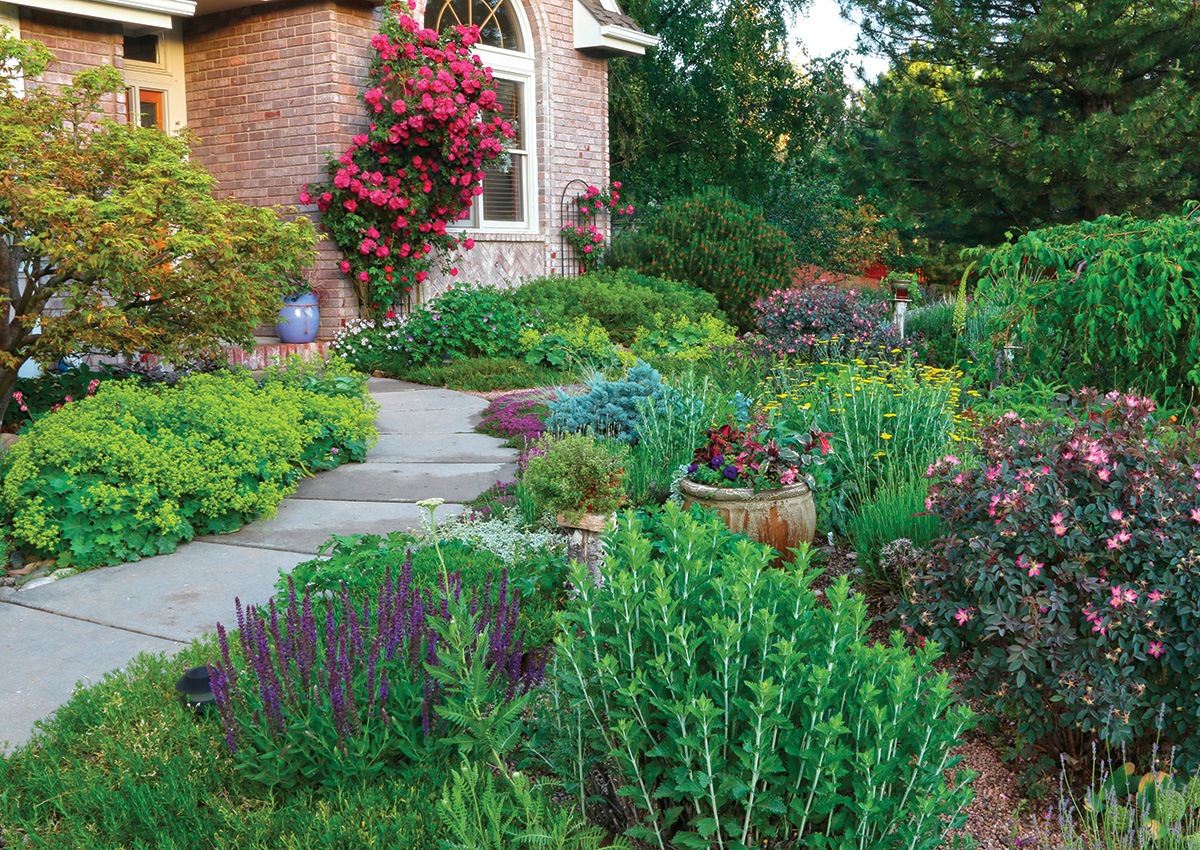Xeriscaping (Water-wise Gardening):
Xeriscaping (Water-wise gardening):
Welcome to the world of xeriscaping, a smart and sustainable approach to gardening! If you’re tired of wasting water on your plants and want to create a beautiful garden while conserving this precious resource, then xeriscaping is perfect for you.
Imagine having a vibrant and thriving garden that doesn’t require excessive watering. With xeriscaping, you can achieve just that! By using drought-tolerant plants, optimizing your irrigation system, and implementing effective water-saving techniques, you can transform your outdoor space into an oasis of sustainable beauty.
In this article, we’ll explore the fascinating world of xeriscaping, learn how to create a water-wise garden, and discover the many benefits that come along with it. So, let’s dive in and uncover the secrets of xeriscaping together!
:max_bytes(150000):strip_icc()/xeriscape-gardening-1402341-hero-1697bc5ab6514491a4b0f0272b6c7ab4.jpg)
Xeriscaping (Water-wise Gardening): Creating a Sustainable Landscape
Xeriscaping, also known as water-wise gardening, is a landscaping technique that focuses on creating beautiful and sustainable landscapes while minimizing water usage. This approach is especially important in areas with limited water resources or regions facing drought conditions. By using native plants, implementing efficient irrigation systems, and practicing responsible water management, xeriscaping allows homeowners and gardeners to enjoy lush gardens while conserving water and reducing maintenance requirements.
The Benefits of Xeriscaping:
Xeriscaping offers numerous benefits for both the environment and homeowners.
1. Water Conservation: By choosing drought-tolerant plants and implementing irrigation systems that deliver water precisely where it is needed, xeriscaping can reduce water usage by up to 50% compared to traditional landscaping methods. This not only helps conserve valuable water resources but also reduces water bills.
2. Environmental Preservation: Xeriscaping promotes the use of native plants, which are adapted to the local climate and require minimal water and maintenance. This approach reduces the need for pesticides and fertilizers, leading to a healthier ecosystem and biodiversity conservation.
3. Cost Savings: While the initial investment in xeriscaping may be higher compared to traditional landscaping methods, the long-term savings in water bills and maintenance costs outweigh the initial expenses. Additionally, xeriscaping can increase property value, making it a wise financial investment.
4. Time Efficiency: Xeriscaped gardens require less maintenance due to the use of low-maintenance plants and efficient irrigation systems. This saves homeowners valuable time that can be spent enjoying the outdoor space rather than constantly maintaining it.
5. Aesthetically Pleasing: Contrary to the belief that xeriscaping results in barren and dry landscapes, well-planned xeriscaped gardens can be just as visually stunning as any traditional garden. Native plants can provide vibrant colors, interesting textures, and attractive foliage, creating a beautiful and unique landscape.
Now that we’ve discussed the benefits of xeriscaping, let’s delve deeper into the key aspects of creating a water-wise garden.
Choosing Drought-Tolerant Plants for Your Xeriscaped Garden:
Selecting the right plants for your xeriscaped garden is crucial for its success. Drought-tolerant plants are those that have adapted to survive in arid conditions and require minimal watering once established. Here are some popular choices:
1. Succulents: Succulents store water in their leaves, stems, or roots, making them excellent choices for xeriscaping. They come in a wide variety of colors, shapes, and sizes, adding visual interest and texture to the garden.
2. Native Grasses: Native grasses are well-suited for xeriscaping as they have evolved to thrive in the local climate and soil conditions. They require minimal water, provide erosion control, and can create a natural meadow-like look.
3. Mediterranean Plants: Plants from Mediterranean climates, such as lavender, rosemary, and sage, are ideal for xeriscaping. They not only thrive in dry conditions but also offer fragrant aromas and attractive flowers.
4. Ornamental Grasses: Ornamental grasses are low-maintenance and add movement and texture to a xeriscaped garden. They come in various heights and colors, providing visual interest year-round.
It’s important to research and choose plants that suit your region’s climate and soil conditions. Consider factors such as sun exposure, drainage, and water requirements when selecting plants for your xeriscaped garden.
Efficient Irrigation Systems for Water-wise Gardening:
Once you have selected the appropriate drought-tolerant plants, implementing an efficient irrigation system is essential to ensure minimal water wastage. Here are some irrigation techniques commonly used in xeriscaping:
1. Drip Irrigation: Drip irrigation is a highly efficient method that delivers water directly to the plant’s root zone, minimizing evaporation and runoff. This system uses porous tubes or emitters to drip water slowly and steadily, providing the plants with a consistent water supply.
2. Microsprays: Microsprays are ideal for smaller garden areas and provide a fine mist of water. They can be adjusted to target specific plant zones and prevent water wastage.
3. Rainwater Harvesting: Incorporating rainwater harvesting systems into your xeriscaped garden can significantly reduce water consumption. Collecting rainwater in barrels or cisterns allows you to utilize nature’s gift during drier periods.
4. Smart Irrigation Controllers: Smart controllers use weather data and evapotranspiration rates to schedule irrigation, ensuring the garden receives the appropriate amount of water. They can also be programmed to adjust irrigation based on rainfall, further conserving water.
By combining appropriate plant selection with efficient irrigation methods, you can create a sustainable and visually appealing xeriscaped garden.
Let’s explore some additional aspects of xeriscaping to help you achieve a water-wise and beautiful landscape.
Implementing Hardscape Elements in Xeriscaping:
Incorporating hardscape elements into your xeriscaped garden can enhance its beauty, functionality, and sustainability. Hardscaping refers to non-living features such as pathways, retaining walls, patios, and decorative rocks. Here are some ways to incorporate hardscaping in your water-wise garden:
1. Permeable Paving: Instead of using traditional impermeable pavement, consider using permeable materials such as gravel, permeable concrete, or porous paving blocks. These allow rainwater to infiltrate the ground, replenishing the water table.
2. Mulching: Mulching not only adds an attractive aesthetic to the garden but also helps retain soil moisture. Organic mulches like wood chips, straw, or bark provide insulation, reduce weed growth, and minimize water evaporation.
3. Dry River Beds: Dry river beds are not only visually appealing but also serve a practical purpose. They can redirect and collect rainwater, preventing erosion and providing moisture to nearby plants.
4. Raised Beds: Raised beds are an excellent option for xeriscaping as they provide better drainage and prevent excessive water accumulation. They can be filled with well-draining soil and be used to grow vegetables, herbs, or decorative plants.
By incorporating hardscape elements thoughtfully, you can create an aesthetically pleasing xeriscaped garden that requires minimal maintenance and conserves water.
Key Takeaways: Xeriscaping (Water-wise gardening)
- Xeriscaping is a method of gardening that conserves water.
- It involves choosing native plants that are adapted to the local climate.
- Using mulch and proper soil preparation helps retain moisture in the garden.
- Xeriscaping includes efficient irrigation techniques, such as drip irrigation.
- By implementing xeriscaping principles, you can save water and create a beautiful, sustainable garden.
Frequently Asked Questions
Welcome to our FAQ section on xeriscaping! Below, you’ll find answers to common questions about water-wise gardening practices. Whether you’re new to xeriscaping or looking to expand your knowledge, we’ve got you covered.
1. What is xeriscaping and why is it important?
Xeriscaping is a landscaping technique that focuses on conserving water by using plants that are adapted to dry conditions. It involves using drought-resistant plants, efficient irrigation systems, and strategic design principles. Xeriscaping is important because it helps reduce water usage, saves money on utility bills, and promotes sustainability. By designing landscapes that are well-suited to the local climate, xeriscaping can create beautiful outdoor spaces while minimizing the need for excessive watering.
Additionally, xeriscaping can help combat water scarcity and drought conditions. By reducing the demand for water-intensive plants, xeriscaping practices can contribute to overall water conservation efforts in communities.
2. Can I still have a lush and colorful garden with xeriscaping?
Absolutely! Xeriscaping doesn’t mean sacrificing a vibrant and beautiful garden. While xeriscaped gardens may have a different aesthetic compared to traditional gardens, they can still be lush, colorful, and visually appealing. By selecting drought-resistant plants that thrive in your local climate, you can create a garden that bursts with color throughout the year.
Consider incorporating a variety of plant species, such as flowering perennials, ornamental grasses, and native shrubs. These plants can provide vibrant blooms, interesting textures, and attractive foliage, resulting in a visually stunning landscape. With thoughtful planning and creativity, it’s possible to achieve a lush and colorful garden while practicing water-wise gardening with xeriscaping.
3. How do I start xeriscaping my garden?
If you’re ready to embrace xeriscaping in your garden, here are some steps to get started:
– Assess your garden’s current water usage and identify areas that can be improved.
– Research native and drought-resistant plants that are well-suited to your climate.
– Plan your garden layout and consider factors like sunlight, soil conditions, and water availability.
– Install efficient irrigation systems, such as drip irrigation or rainwater harvesting techniques.
– Prepare the soil by adding organic matter and mulch to improve moisture retention.
– Plant your chosen drought-resistant plants and monitor their growth and water needs.
– Regularly maintain and care for your xeriscaped garden by weeding, pruning, and making adjustments as needed.
Remember, xeriscaping is a process that evolves over time, and it can be tailored to suit your specific garden and preferences.
4. Is xeriscaping suitable for all climates?
Xeriscaping can be adapted to suit different climates, but certain techniques and plant selections may vary. While xeriscaping is often associated with arid regions, it can be beneficial in a range of climates, including dry and semi-arid regions.
In areas with ample rainfall, the focus may be on selecting plants that can withstand periodic droughts and don’t require excessive watering. In regions with low rainfall, xeriscaping may involve using plants that are specifically adapted to arid conditions and implementing more water-conserving strategies.
By researching and selecting plants that are well-suited to your local climate, you can create a xeriscaped garden that thrives in a variety of conditions.
5. What are the long-term benefits of xeriscaping?
Implementing xeriscaping techniques can bring a range of long-term benefits to your garden and the environment:
– Water conservation: Xeriscaping significantly reduces water usage, resulting in both cost and environmental savings. It helps preserve precious water resources in regions prone to drought and water scarcity.
– Reduced maintenance: Xeriscaped gardens often require less maintenance compared to traditional gardens. By using native and drought-resistant plants, you can minimize the need for regular watering, mowing, and fertilizing.
– Lower utility bills: With reduced water consumption, xeriscaping can lead to lower water bills over time. Additionally, the decreased need for maintenance can save money on landscaping services.
– Increased biodiversity: By incorporating native plants into your xeriscaped garden, you can attract and support local wildlife, including pollinators like bees and butterflies.
– Improved resilience: Xeriscaping can help your garden withstand periods of drought and extreme weather conditions. The use of drought-resistant plants and efficient irrigation systems can enhance your garden’s resilience and longevity.
By embracing xeriscaping, you can create a sustainable and beautiful outdoor space that benefits both you and the environment.

Water Wise Gardening Tips
Summary
Xeriscaping, or water-wise gardening, is a smart and eco-friendly way to beautify our yards. By using plants that are native to our area and implementing water-saving techniques, we can save water and still have a vibrant garden. Xeriscaping also helps to reduce maintenance and create a habitat for local wildlife.
By choosing drought-tolerant plants and grouping them according to their water needs, we can significantly reduce our water usage. Using mulch and drip irrigation systems can further conserve water and prevent evaporation. With xeriscaping, we can create a sustainable and water-efficient garden that benefits both the environment and our wallets. So let’s get started and make our gardens beautiful while also conserving water!
